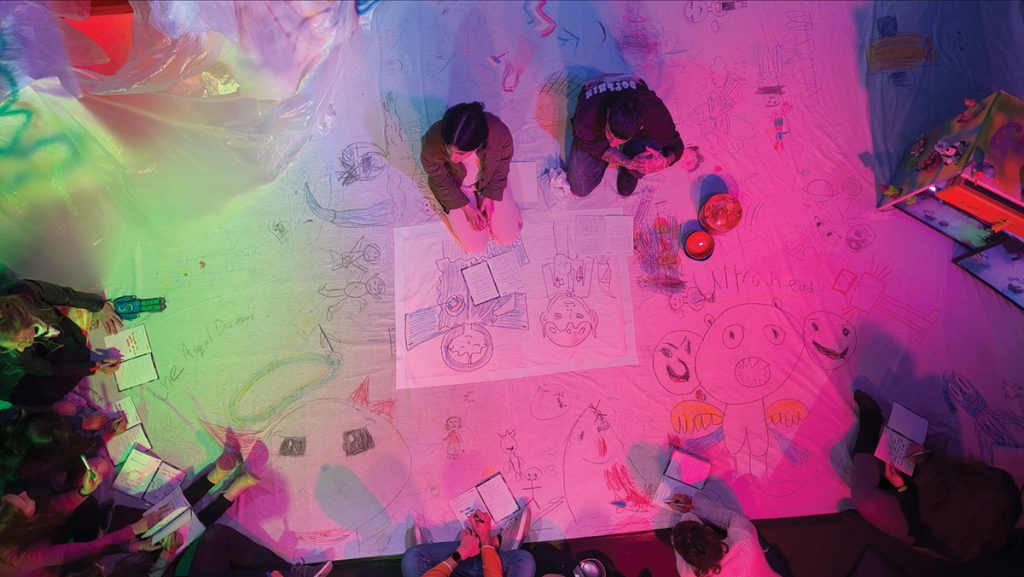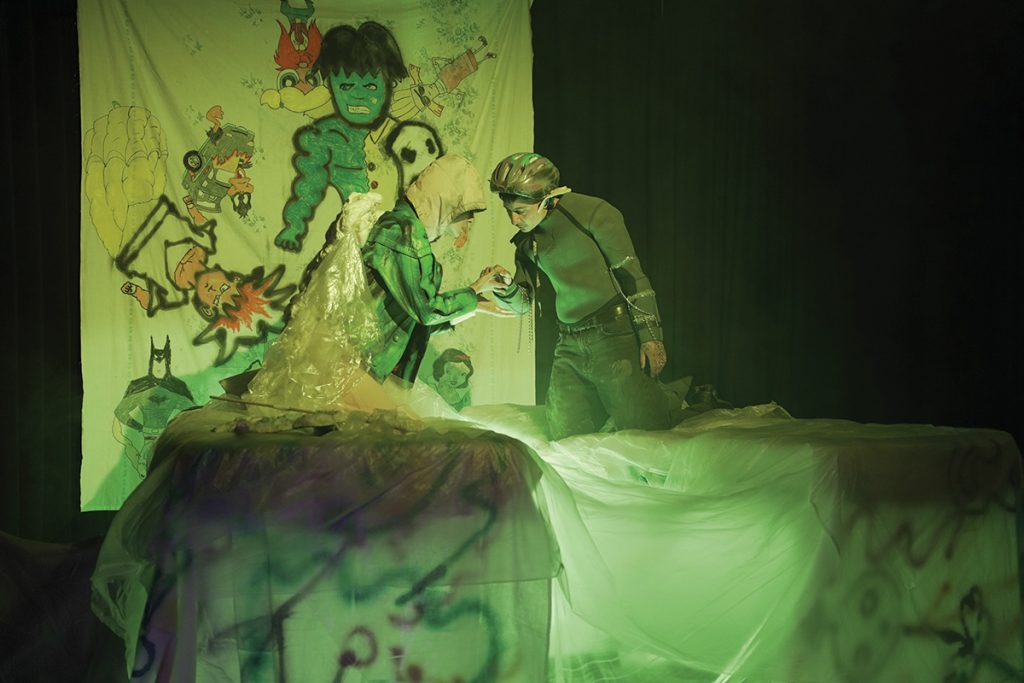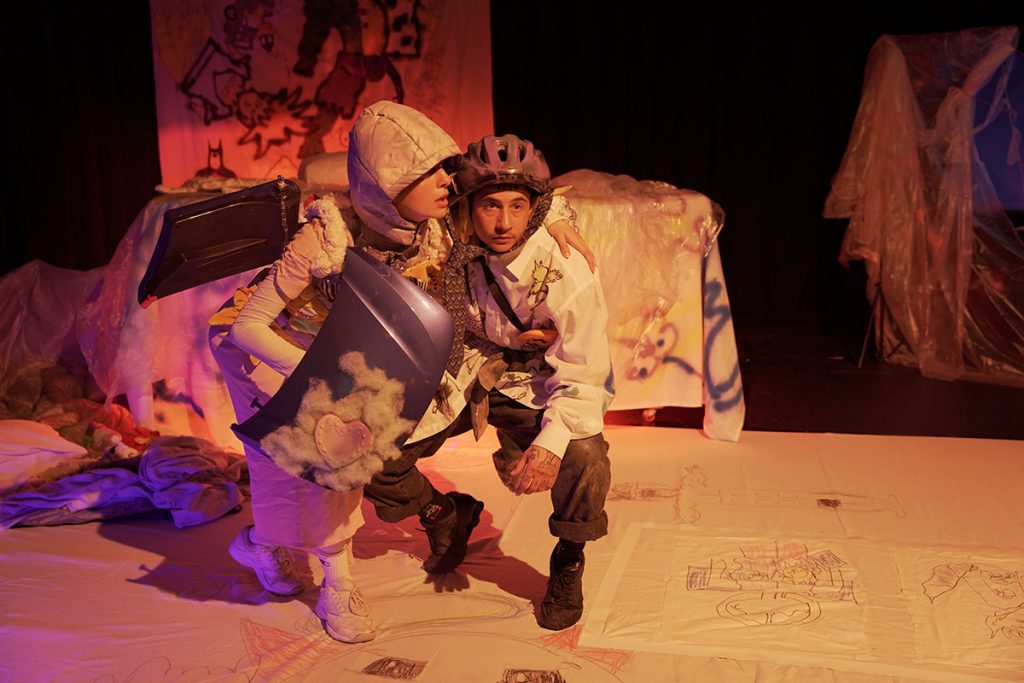Gender Boss
When a disgruntled tooth fairy and a sensitive boogeyman started one of the Island’s most heated discussions.

In a speech sarcastically called ‘Why have there been no great transgender artists’ Jeannine Tong says:
‘Many of us credit these artists with producing great art. I certainly do. And while I don’t doubt artists with complex gender identifications have produced art since the idea was imaginable, within Euro-American modernism the breadth of this recognition is rare. I cite this litany of critics, curators, spaces, and schools to emphasise how greatness emerges through advocacy that is utterly social, situated and spatial.’
The power of art to generate discussion was experienced in Malta during the last ZiguZajg children’s art festival when even prior to the premiere of the performance work ‘Gender Boss’ conceptualised and performed by artists Romeo Roxman Gatt and Martina Georgina several key persons expressed a confused form of concern for the piece.

Ranging from MPs questioning the artists’ ‘abilities’/‘agency’ in parliament when they had not even read the script, insinuating that if one invites children to explore a very real issue through art they are confusing them to a raging discussion on social media, few actually stopped to ask what the work was really about.
I caught up with the artists to discuss the work.
JD : Artists communicate with society through their art. What did you want to communicate when approached to create this work?
RRG/MG : Our main intention from the very start of this project was to create a work that focuses on gender identity and expression, embraces gender diversity and challenges gender stereotypes. We wanted to create a performance that speaks of love as well as embraces differences. As for the workshop we wanted to create a safe space and give agency to children to create their own characters that go on their own journey of self discovery.




JD : What was the process which led to this creation?
RRG/MG : From early on in the process we understood the responsibility we had when asked to create a children’s performance that would centre on gender, especially since it isn’t often the central focus in children’s stories and yet gender most often still forms part of such stories. We understood the complexity of the subject being dealt with within our work and our focus was to address it in a way that would be accessible to children and would give them the ability to engage with it. Our starting point therefore was looking into content that children of that age are already familiar with. We started looking into fairytales, cartoons, films and toys of the target age group. All of this material inspired us to imagine some of these characters wanting to go beyond their often more stereotyped gender roles and behaviours.
JD : The work involves visual props, sound and performance as well as an interactive workshop. Can you elaborate on the various elements which make up this work?
RRG/MG : We wanted to create work that would not only be already familiar to children, but would also be work that is true to our own practice. Performance is an important element in both our work and this is often communicated through multiple mediums including movement, text, sound, video and sculpture. We were intuitively inspired to create a children’s-bedroom-like world as we saw this as the birthplace of endless imagination and where dreams come to life. We later referred to this world as ‘The Land’ which would offer a safe space for our characters to travel to and thus became the set of our performance. We became more and more inspired by ‘The Land’ being a place where our later characters would feel safe to be themselves. We delved into the world of transformations, metamorphosis and shapeshifting that is already found in many children’s content and even created a video work with an edited compilation taken from already existing footage of transformations visible in cartoons and film as well as transformations that happen within the animal kingdom.
We mostly continued working with existing materials. ‘The Land’ was filled with toys and characters which we transformed into other beings, some human, some less human, others animal or a combination of both to emphasise a more fantastical-land. Though ‘The Land’ had an overall punk-like aesthetic we imagined ‘The Land’ to be the ideal world where love would conquer over hate and judgement. A tooth fairy, Toothy, and a boogeyman Boogey were our main characters. ‘The Land’ offered the not so dainty and graceful Toothy the chance to explore her inner superhero and offered the not so scary Boogey a chance to make his first friend. Aunty Turbo, Toothy’s aunt had earlier become a resident at ‘The Land’ Toothy and Boogey travelled to and was a source of inspiration for both characters to accept themselves for wanting to go beyond their fairytale norms.
JD : How did you come about naming this performance?
RRG/MG : The title was inspired by a book we referred to in our initial research titled “Gender Explorers” by Juno Roche. It is a collection of life-affirming interviews focusing on the stories of young gender diverse and trans people who share their empowering experiences of questioning and exploring gender.
‘I believe that children who are questioning and exploring their gender, or simply making gender do what they need it to do in order that they can lead happy, functional and aspirational lives, are the future of this planet. They are the gender explorers and gender bosses that we all so desperately need. Yes, I feel as strongly as that: I believe that they are our future.’ – Gender Explorers, Juno Roche
JD : As multidisciplinary artists with a repertoire of performance pieces, you recognized the need to produce a work of art tailored for a young audience. How was this different from performance works you have made before?
RRG/MG : Although this has been our first collaboration together, we have both dealt with subjects centering around gender amongst other thematics that are often associated with an adult audience. However we also have had experience working with children before, both on other artistic projects and also in schools. Our ongoing discussions have made us realise even more how important it is to expose children to topics that are often deemed complicated or “confusing”.
We are very aware that these assumptions tend to be counterproductive as they not only continue to solidify stereotypes but also end up excluding portions of the population that could potentially have a great effect on the way our future will evolve; one that is a more inclusive and diverse place.
So of course it was crucial for us to take on this project and talk about gender in a way that is accessible and playful for a young audience. As artists, researchers and thinkers we have the power to talk about pressing political issues in a way that can include, involve and be more accessible to all.
JD: In your process do you regularly consider the discussion your work generates? Do you think there s a work of art in malta which generated as much discussion? Is the reaction to a work by the community the most valuable aspect of a work of art?
RRG/MG : There is a place for all kinds of art, but for us personally, the work that we are inclined to create desires the need to communicate and pose questions that might often seem uncomfortable, or not so easy to talk about and this instantly opens up a space for discussion. This work in particular generated attention that wasn’t necessarily the one we were interested in partaking in, especially when the discussions being held around it were prior to the work ever being shown. We quickly realised that since we were not completely able to enter such heated discussions that did not feel safe, we understood we had a responsibility to our approaching audiences and could only engage once the work would have been seen. We always believed that this work was really important for us to make, however it was only post-project that we realised how a work like this is necessary.
The children and adults who did come to see the performance as well as take part in the workshop, generously shared with us how such a work needs to exist especially amidst all the prejudice that was experienced prior. It is important to continue to follow up on these discussions and to know that this kind of work makes visible as well as gives a little hope to those who are often left in the dark, alone and lost.
JD : The audience this work was meant for responded by creating characters, drawings, and continued thinking about the work from home as evidenced by the thoughts they wrote on the workbooks you handed out. Do you see this as an elaboration of the work? Many contemporary art pieces today are about documenting the process and narrative. A performance art work with an open ended invitation to the audience to continue thinking, writing, drawing and documenting enriches the piece. Do you agree?
RRG/MG : At a later stage in our production period we came up with this idea where the floor of our performance space would be covered in a white sheet. Every time we performed we drew our transformed character on this sheet. This excited us in thinking that our audiences could also contribute their own drawings within the set, and hence become a part of the work themselves. This is when we came up with the idea of inviting the kids to draw their own creatures on this sheet. In the end we ended up with a large drawing filled with creatures that the kids would have created in their workbook during the workshop. This compilation of drawings became a collective artwork which feels less individual and more communal and that is also something that felt quite fitting to this particular work especially since the children’s involvement, ideas and agency were central to us and the work.
JD : What’s next? Will the work be touring? Do you think the invitation should be for people of all ages?
RRG/MG : We would like it to tour and to be experienced by more audiences for sure. We feel that many people, specifically children, unfortunately missed out on the chance of seeing Gender Boss due to the controversy that preceded the performance. We hope that there will be other opportunities for us to deliver this work, and hopefully this time it will be welcomed with a more open and less judgemental mindset.









